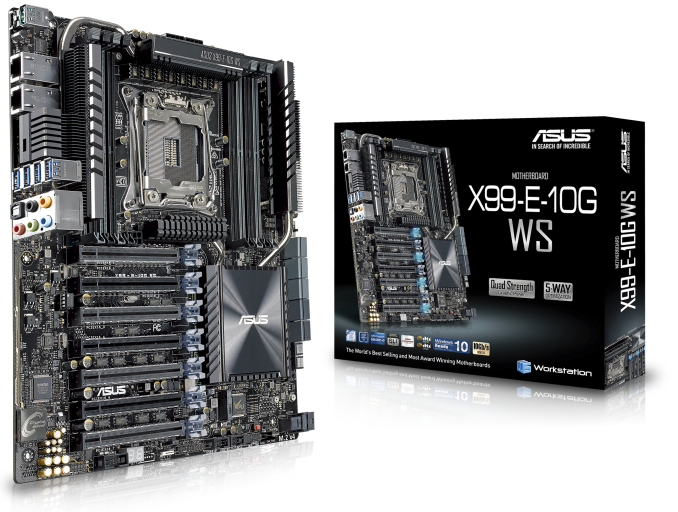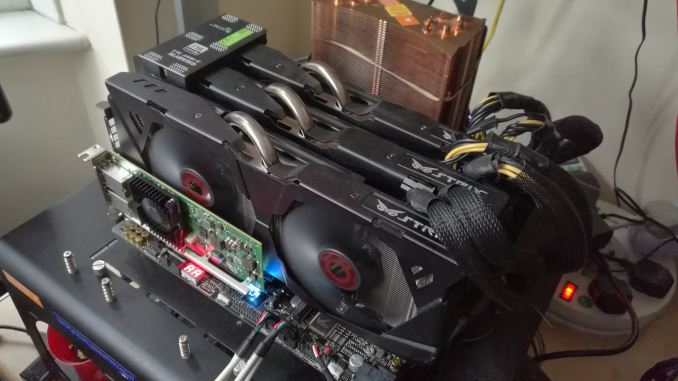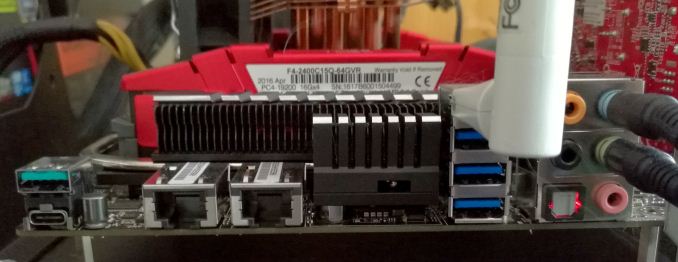The ASUS X99-E-10G WS Motherboard Review: 10GBase-T Networking with Intel’s X550-AT2
by Ian Cutress on November 7, 2016 9:00 AM EST- Posted in
- Motherboards
- Intel
- Asus
- 10G Ethernet
- X99
- 10GBase-T
- X99-E-10G WS
- X550
- X550-AT2
ASUS X99-E-10G WS Conclusion
As ASUS’ newest high-end desktop motherboard model, the X99-E-10G WS comes out with almost all guns blazing. It is hard to escape how much functionality is present, from a full complement of PCIe lanes (x16/x16/x16/x16) to dual 10G copper Ethernet ports to a full set of DRAM (and support for ECC Registered for Xeons) as well as PCIe storage for either M.2 or U.2 and USB 3.1 ports. Pretty much everything you need, except perhaps Thunderbolt 3, is here.
Ultimately this also pigeon holes the X99-E-10G WS into a highly specific market. Providing all this functionality isn’t cheap with the motherboard having to use two expensive Avago PCIe switches (PLX8747) and Intel’s newest PCIe 3.0 x4 X550-AT2 controller. This squares the motherboard down to users who needed 10G ports but were already lacking PCIe space. The numbers of users who qualify in that margin are set to be very low. Here’s an example of a use case: three GTX 980s with another 10G card (X540, PCIe 2.0 x8) attached in the bottom slot.
For performance, ASUS implements Multi-Core Turbo with the Core i7-5960X which gives our CPU benchmark results in the top half, but due to the PLX chip incurring a ~1% performance penalty, our gaming tests are the lowest we’ve seen for this set of tests on X99. For system benchmarks, the use of extra controllers does add to the POST time, but the audio performance is very good as well as USB 3.0/3.1 (with Turbo) and DPC Latency (one of ASUS’ recent strong points).
The BIOS and software side of the equation is ASUS’ usual consumer fare, and despite the X99-E-10G WS being a workstation focused board, aside from ECC Registered DRAM support with Xeons, there is nothing (nothing on the software side at least) that is specifically derived for workstations or prosumers that isn’t already on consumer platforms. That being said, fan controls, power and USB features are still relevant for most users.
The ASUS X99-E-10G WS does one thing really well – it offers the best single-socket option for integrated 10G support in the current market, and we will hopefully see more down the line (or at lower price points). As mentioned in our 10GBase-T motherboard overview earlier in the year, aside from the ASUS and ASRock boards available, and MSI’s C236 board with a single 10G port, options for integrated solutions are few and far between. Aside from switch pricing the ecosystem for home use, even as a prosumer play, needs to be driven by either switch availability (something like ASUS’ XG-U2008 at $250) or motherboard/PC adoption. So even at $600, the ASUS X99-E-10G WS shows how easy it can be to integrate 10G copper in the form of 10GBase-T.
Other Intel X99 Motherboard Reviews by AnandTech:
Prices Correct at time of each review
$750: The ASRock X99 WS-E 10G Review [link]
$600: The ASUS X99-E-10G WS Review (this review)
$600: The ASRock X99 Extreme11 Review [link]
$500: The ASUS Rampage V Extreme Review [link]
$400: The ASUS X99-Deluxe Review [link]
$340: The GIGABYTE X99-Gaming G1 WiFi Review [link]
$330: The ASRock X99 OC Formula Review [link]
$323: The ASRock X99 WS Review [link]
$310: The GIGABYTE X99-UD7 WiFi Review [link]
$310: The ASUS X99 Sabertooth Review [link]
$300: The GIGABYTE X99-SOC Champion Review [link]
$300: The ASRock X99E-ITX Review [link]
$300: The MSI X99S MPower Review [link]
$275: The ASUS X99-A Review [link]
$241: The MSI X99S SLI PLUS Review [link]













63 Comments
View All Comments
karakarga - Wednesday, November 9, 2016 - link
If you connect a new modem or access point, having 5GHz or newest 60GHz, you need more than 150 megabytes, thus you need faster than 1Gigabit ethernet transfer speed....eek2121 - Wednesday, November 9, 2016 - link
Speak for yourself. Anyone in the photography or content creator will benefit from the faster speeds. Hell, even at my level I could use good 10 Gig hardware for the generation, transferring, storage, and streaming of 4K content across the network to/from a NAS, all while streaming my Blu-ray library to multiple locations in the house and playing a game at the same time.firefoxx04 - Tuesday, November 22, 2016 - link
Are you kidding me? Nobody? Not even someone buying a workstation board with 8+ core support and 16/16/16/16 PCIe support?I just added a 10Gbit fiber card to my desktop and my file server (raid5 with 4 drives) and im getting over twice as much throughput as I was before with no tuning to the driver. 112Mb/s network transfers feel slow now when my desktop is capable of 250-300Mb/s sustained. Hell, I even installed my entire steam library onto my network share because its simply fast enough (with no latency thanks to fiber optics).
But yeah, nobody could possibly benefit from 10G.
eSyr - Monday, November 7, 2016 - link
PCIe switch adds about 100—300ns to RTT, I don't think it would be critical for audio applications.nirsever - Tuesday, November 8, 2016 - link
Actually, there is a rather major shift towards 2.5G and 5G happening these days. It is driven primarily by:+ The recent ratification of the IEEE 802.3bz standard
+ Higher than 1G bandwidth demand of Wave2 11.ac WiFi APs coming up with 2.5G and 5G LAN ports
+ Availability of low cost and low power solutions from Tehuti Networks with PHYs from Marvell and Aquantia
BillR - Tuesday, November 8, 2016 - link
The rumor I heard is that extending a 1G PHY to work at 2.5G didn't add a lot to the price and power (about 30-50% in extra logic/power). Running at 5G my require a lot of the same logic used in a 10G PHY so a 5G solution would not offer huge power/cost advantages over 10G.nirsever - Wednesday, November 9, 2016 - link
I agree with your observation that cost wise, 5G and 10G are the same. However, from our experience, 5G power consumption is significantly lower than 10G. In addition, investing in 5G/2.5G capable NIC gives you the benefit of extending the life of your existing Cat5e/Cat6 cabling beyond 1G which is not possible with "classic" 10GBase-TBillR - Wednesday, November 9, 2016 - link
I agree.BrokenCrayons - Monday, November 7, 2016 - link
Just a thought...for a motherboard review, the feature image doesn't really show the motherboard or have a lot to do with the headline discussing networking.alamilla - Monday, November 7, 2016 - link
For an updated board it seems strange that they removed the Thunderbolt header with no options for Thunderbolt 3 expansion.Disappointing... :(